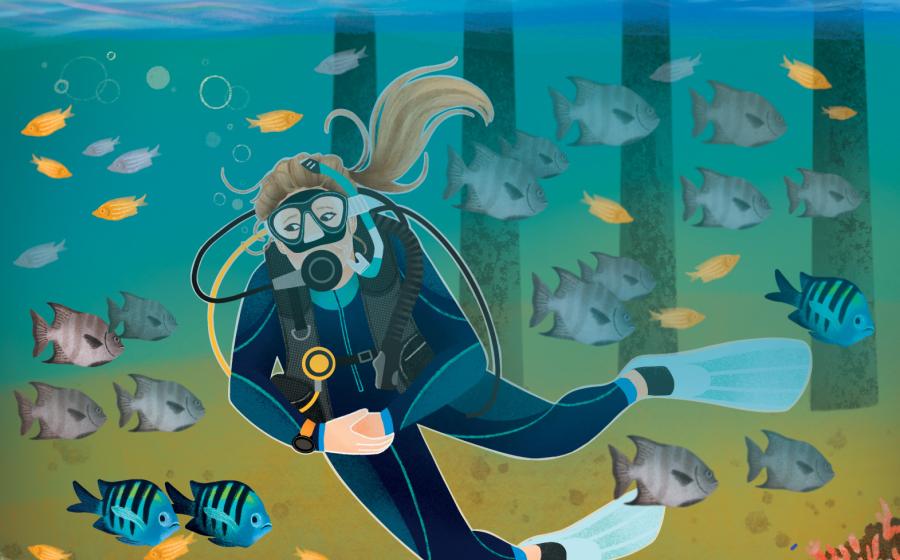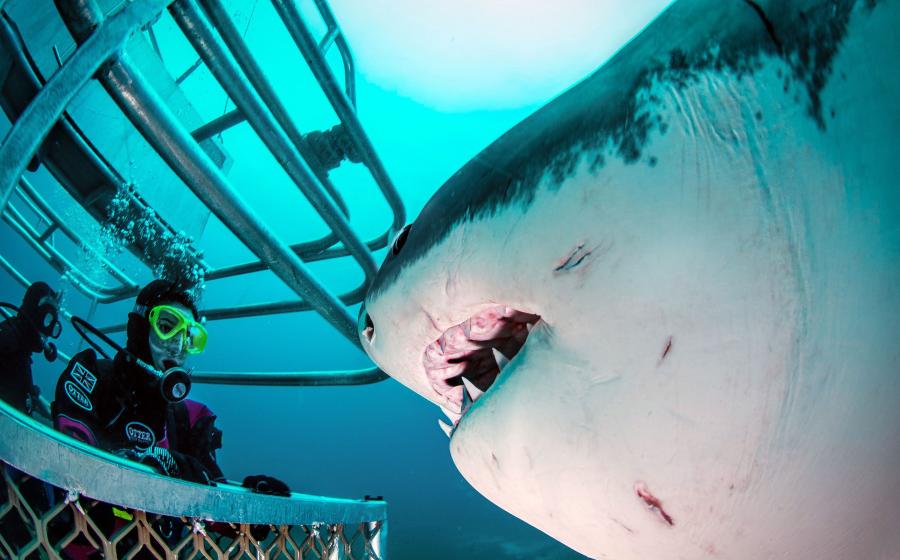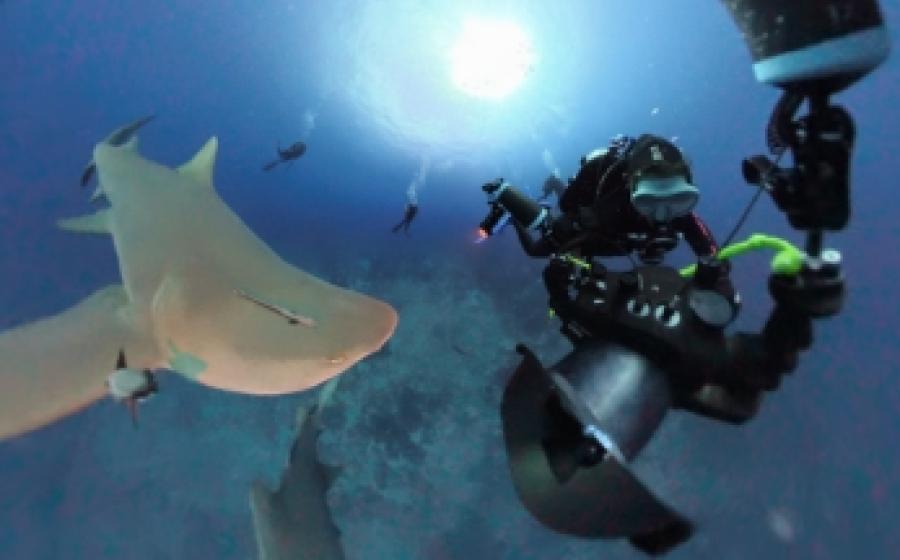Camera Kits for Cold Water
Get the Shot
Television producer Neil Lucas became interested in diving when he joined the BBC some 20 years ago. He is now a dive master, and working on a new series for the BBC called Life, which is a sort of follow up to the renowned Planet Earth series. That is what brought him to Antarctica, and the ice diving at McMurdo Station, the subject of our June issue’s Advanced Adventure. Here’s what he uses to get his shots:
Neil Lucas’ Underwater Kit
 My underwater stills camera is a Nikon D200 in a Sea & Sea DX housing, which has been adapted for an external battery pack and motion control unit for my work with the BBC. But for normal stills, I use it as a straight forward housing. On most trips I also take this set of lenses with me:
My underwater stills camera is a Nikon D200 in a Sea & Sea DX housing, which has been adapted for an external battery pack and motion control unit for my work with the BBC. But for normal stills, I use it as a straight forward housing. On most trips I also take this set of lenses with me:
- Nikkor 10.5mm f2.8G ED, with an Optical Dome Port
- Nikkor 12mm – 24mm f4G (IF) with the same port and an extension ring
- Nikkor 105mm Macro F2.8G ED VR with a compact macro flat port
I also use two Sea & Sea YS 110 TTL strobes linked to the housing with a Sea & Sea TTL Converter II. This gives me greater control and flexibility. Battery life is always a problem in cold water — the life in them just seems to drain away. The ones that seem to work best for me are rechargeable 5000mAH nickel-metal hydride C cells. Even though they can last for a complete dive, I still carry a spare set as well as a backup supply of standard Energizer or Duracell’s. If I know I’m going to be away for awhile, I also make sure that all my rechargeable batteries are new, and have been recycled a few times to make sure they are in top condition. For me the Sea & Sea housing is a great all round robust piece of equipment. I find the large controls are easy to reach and have a firm response. This is important when working in cold water because if your hands have gone numb, it’s not always possible to feel each click of a knob or push button, especially if you’re wearing extra thick gloves and liners to keep warm. Condensation inside a housing or on a camera lens can be a real pain and blow the whole shoot. So I always try to keep the housing and camera at as even a temperature as possible throughout the day, even if that means leaving the nice warm dive hut for the ice and snow outside before opening the back of the housing to swap memory cards or change the camera battery. It may be cold out there, but this approach always seems to work for me. Stay tuned to www.bbc.co.uk and www.bbcamerica.com for updates on the release the Life series.
Lisa Trotter
 Lisa Trotter actually learned to dive in the Antarctic, and has since reached the level of Dive Master and logged more than 900 hours in the frigid waters using both scuba and a remotely operated vehicle. She began working aboard Lindblad Expeditions’ Endeavour in 2000, and now spends 9 months a year working onboard National geographic Explorer and National Geographic Endeavour as Expedition Leader and Undersea Specialist. Here’s what she uses to get the shot: Lisa Trotter’s Underwater Kit
Lisa Trotter actually learned to dive in the Antarctic, and has since reached the level of Dive Master and logged more than 900 hours in the frigid waters using both scuba and a remotely operated vehicle. She began working aboard Lindblad Expeditions’ Endeavour in 2000, and now spends 9 months a year working onboard National geographic Explorer and National Geographic Endeavour as Expedition Leader and Undersea Specialist. Here’s what she uses to get the shot: Lisa Trotter’s Underwater Kit  For shooting video, I use a Light and Motion Blue Fin housing for a Sony FX-1, with Sun Ray LED Lights with the extra-large battery packs. For shooting stills, I use a Nexus D70 underwater housing, with twin Sea & Sea YS-110 Strobes (the focus lights are fantastic in waters where visibility and natural light can be minimal). In the past, I have had difficulty with my CF cards working well in such cold water, but since switching to the San Disk Extreme 3 cards, it’s smooth sailing. You’ll also want to check out this video of Lisa diving in Antarctica with Lindblad Expeditions. Voyages on Lindblad’s renowned expedition vessels have taken Lisa from the remote islands of the Mid-Atlantic Ridge to Europe, as well as both coasts of South America and the Azores. She has also participated in expeditions by Russian Icebreaker to Antarctica’s Ross and Weddell Seas and the High Arctic archipelago of Franz Josef Land. But her latest scuba diving adventure with Lindblad will be in water of a different temperature: French Polynesia. And guess what? You’re invited. The Hanse Explorer: Sailing French Polynesia by Private Yacht expedition is a new offering from Lindblad, and takes just 12 guests on the intimate Hanse Explorer yacht through the Society and Tuamotu islands. The special itinerary features loads of diving, and is led by Lisa and Lindblad expedition leader Tim Soper. The 10-night voyage departs on with June 18 or June 28 2009, and costs $9,990. Visit www.expeditions.com or call 1-800- Expedition for details.
For shooting video, I use a Light and Motion Blue Fin housing for a Sony FX-1, with Sun Ray LED Lights with the extra-large battery packs. For shooting stills, I use a Nexus D70 underwater housing, with twin Sea & Sea YS-110 Strobes (the focus lights are fantastic in waters where visibility and natural light can be minimal). In the past, I have had difficulty with my CF cards working well in such cold water, but since switching to the San Disk Extreme 3 cards, it’s smooth sailing. You’ll also want to check out this video of Lisa diving in Antarctica with Lindblad Expeditions. Voyages on Lindblad’s renowned expedition vessels have taken Lisa from the remote islands of the Mid-Atlantic Ridge to Europe, as well as both coasts of South America and the Azores. She has also participated in expeditions by Russian Icebreaker to Antarctica’s Ross and Weddell Seas and the High Arctic archipelago of Franz Josef Land. But her latest scuba diving adventure with Lindblad will be in water of a different temperature: French Polynesia. And guess what? You’re invited. The Hanse Explorer: Sailing French Polynesia by Private Yacht expedition is a new offering from Lindblad, and takes just 12 guests on the intimate Hanse Explorer yacht through the Society and Tuamotu islands. The special itinerary features loads of diving, and is led by Lisa and Lindblad expedition leader Tim Soper. The 10-night voyage departs on with June 18 or June 28 2009, and costs $9,990. Visit www.expeditions.com or call 1-800- Expedition for details.  Intrigued by Antarctica but don’t have the dry suit dives to make an underwater expedition happen? Go topside with the Antarctica or the South Georgia and Falklands islands expedition aboard the [National Geographic Explorer](/files/_attachments/EX_Deck Plan.pdf).
Intrigued by Antarctica but don’t have the dry suit dives to make an underwater expedition happen? Go topside with the Antarctica or the South Georgia and Falklands islands expedition aboard the [National Geographic Explorer](/files/_attachments/EX_Deck Plan.pdf).
Get the Shot
Television producer Neil Lucas became interested in diving when he joined the BBC some 20 years ago. He is now a dive master, and working on a new series for the BBC called Life, which is a sort of follow up to the renowned Planet Earth series. That is what brought him to Antarctica, and the ice diving at McMurdo Station, the subject of our June issue’s Advanced Adventure. Here’s what he uses to get his shots:
Neil Lucas’ Underwater Kit
 My underwater stills camera is a Nikon D200 in a Sea & Sea DX housing, which has been adapted for an external battery pack and motion control unit for my work with the BBC. But for normal stills, I use it as a straight forward housing. On most trips I also take this set of lenses with me:
My underwater stills camera is a Nikon D200 in a Sea & Sea DX housing, which has been adapted for an external battery pack and motion control unit for my work with the BBC. But for normal stills, I use it as a straight forward housing. On most trips I also take this set of lenses with me:
- Nikkor 10.5mm f2.8G ED, with an Optical Dome Port
- Nikkor 12mm – 24mm f4G (IF) with the same port and an extension ring
- Nikkor 105mm Macro F2.8G ED VR with a compact macro flat port I also use two Sea & Sea YS 110 TTL strobes linked to the housing with a Sea & Sea TTL Converter II. This gives me greater control and flexibility. Battery life is always a problem in cold water — the life in them just seems to drain away. The ones that seem to work best for me are rechargeable 5000mAH nickel-metal hydride C cells. Even though they can last for a complete dive, I still carry a spare set as well as a backup supply of standard Energizer or Duracell’s. If I know I’m going to be away for awhile, I also make sure that all my rechargeable batteries are new, and have been recycled a few times to make sure they are in top condition. For me the Sea & Sea housing is a great all round robust piece of equipment. I find the large controls are easy to reach and have a firm response. This is important when working in cold water because if your hands have gone numb, it’s not always possible to feel each click of a knob or push button, especially if you’re wearing extra thick gloves and liners to keep warm. Condensation inside a housing or on a camera lens can be a real pain and blow the whole shoot. So I always try to keep the housing and camera at as even a temperature as possible throughout the day, even if that means leaving the nice warm dive hut for the ice and snow outside before opening the back of the housing to swap memory cards or change the camera battery. It may be cold out there, but this approach always seems to work for me. Stay tuned to www.bbc.co.uk and www.bbcamerica.com for updates on the release the Life series.
Lisa Trotter
 Lisa Trotter actually learned to dive in the Antarctic, and has since reached the level of Dive Master and logged more than 900 hours in the frigid waters using both scuba and a remotely operated vehicle. She began working aboard Lindblad Expeditions’ Endeavour in 2000, and now spends 9 months a year working onboard National geographic Explorer and National Geographic Endeavour as Expedition Leader and Undersea Specialist. Here’s what she uses to get the shot: Lisa Trotter’s Underwater Kit
Lisa Trotter actually learned to dive in the Antarctic, and has since reached the level of Dive Master and logged more than 900 hours in the frigid waters using both scuba and a remotely operated vehicle. She began working aboard Lindblad Expeditions’ Endeavour in 2000, and now spends 9 months a year working onboard National geographic Explorer and National Geographic Endeavour as Expedition Leader and Undersea Specialist. Here’s what she uses to get the shot: Lisa Trotter’s Underwater Kit  For shooting video, I use a Light and Motion Blue Fin housing for a Sony FX-1, with Sun Ray LED Lights with the extra-large battery packs. For shooting stills, I use a Nexus D70 underwater housing, with twin Sea & Sea YS-110 Strobes (the focus lights are fantastic in waters where visibility and natural light can be minimal). In the past, I have had difficulty with my CF cards working well in such cold water, but since switching to the San Disk Extreme 3 cards, it’s smooth sailing. You’ll also want to check out this video of Lisa diving in Antarctica with Lindblad Expeditions. Voyages on Lindblad’s renowned expedition vessels have taken Lisa from the remote islands of the Mid-Atlantic Ridge to Europe, as well as both coasts of South America and the Azores. She has also participated in expeditions by Russian Icebreaker to Antarctica’s Ross and Weddell Seas and the High Arctic archipelago of Franz Josef Land. But her latest scuba diving adventure with Lindblad will be in water of a different temperature: French Polynesia. And guess what? You’re invited. The Hanse Explorer: Sailing French Polynesia by Private Yacht expedition is a new offering from Lindblad, and takes just 12 guests on the intimate Hanse Explorer yacht through the Society and Tuamotu islands. The special itinerary features loads of diving, and is led by Lisa and Lindblad expedition leader Tim Soper. The 10-night voyage departs on with June 18 or June 28 2009, and costs $9,990. Visit www.expeditions.com or call 1-800- Expedition for details.
For shooting video, I use a Light and Motion Blue Fin housing for a Sony FX-1, with Sun Ray LED Lights with the extra-large battery packs. For shooting stills, I use a Nexus D70 underwater housing, with twin Sea & Sea YS-110 Strobes (the focus lights are fantastic in waters where visibility and natural light can be minimal). In the past, I have had difficulty with my CF cards working well in such cold water, but since switching to the San Disk Extreme 3 cards, it’s smooth sailing. You’ll also want to check out this video of Lisa diving in Antarctica with Lindblad Expeditions. Voyages on Lindblad’s renowned expedition vessels have taken Lisa from the remote islands of the Mid-Atlantic Ridge to Europe, as well as both coasts of South America and the Azores. She has also participated in expeditions by Russian Icebreaker to Antarctica’s Ross and Weddell Seas and the High Arctic archipelago of Franz Josef Land. But her latest scuba diving adventure with Lindblad will be in water of a different temperature: French Polynesia. And guess what? You’re invited. The Hanse Explorer: Sailing French Polynesia by Private Yacht expedition is a new offering from Lindblad, and takes just 12 guests on the intimate Hanse Explorer yacht through the Society and Tuamotu islands. The special itinerary features loads of diving, and is led by Lisa and Lindblad expedition leader Tim Soper. The 10-night voyage departs on with June 18 or June 28 2009, and costs $9,990. Visit www.expeditions.com or call 1-800- Expedition for details.  Intrigued by Antarctica but don’t have the dry suit dives to make an underwater expedition happen? Go topside with the Antarctica or the South Georgia and Falklands islands expedition aboard the [National Geographic Explorer](/files/_attachments/EX_Deck Plan.pdf).
Intrigued by Antarctica but don’t have the dry suit dives to make an underwater expedition happen? Go topside with the Antarctica or the South Georgia and Falklands islands expedition aboard the [National Geographic Explorer](/files/_attachments/EX_Deck Plan.pdf).






